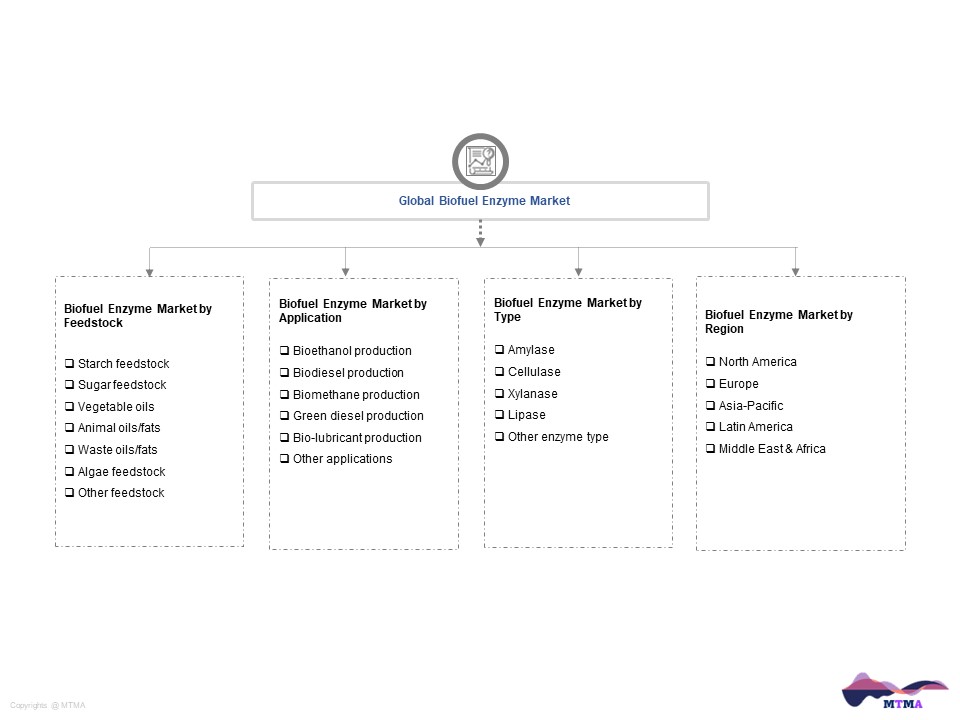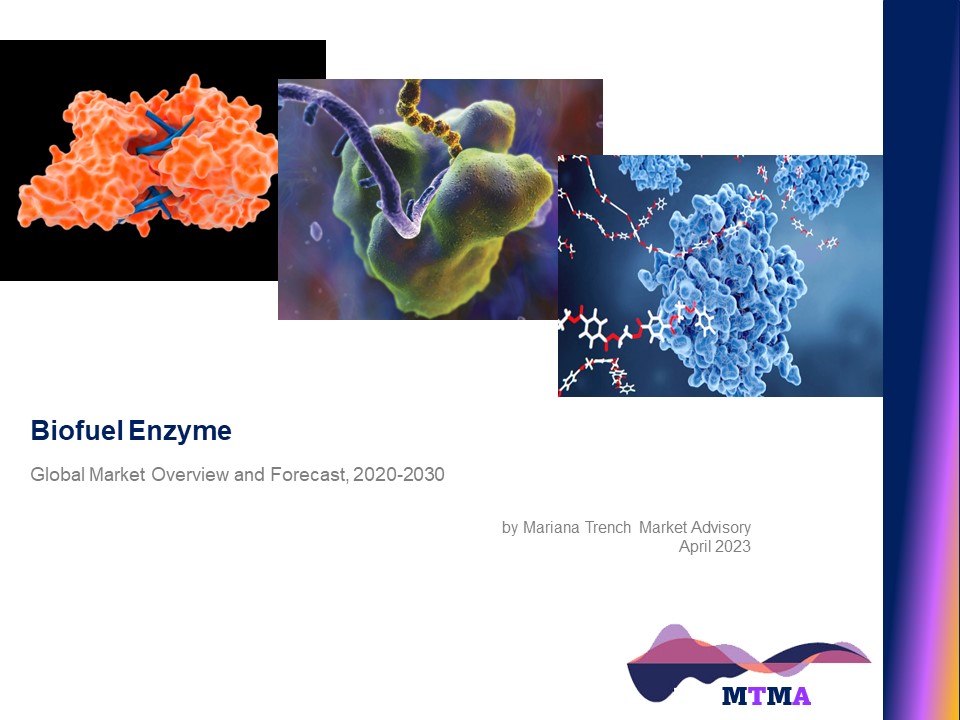- Overvew
- Table of Content
- Segmentation
- Request Sample
Market Definition
Enzymes function as catalysts and are essential for accelerating reaction rates. Both simple and sophisticated biological things exhibit the catalytic abilities of enzymes. All other enzymes are proteins formed primarily of amino acid chains that are connected by peptide bonds, with the exception of a limited number of enzymes that are composed of tiny catalytic RNA molecules. Enzymes are frequently multiprotein complexes made up of numerous distinct protein subunits. The molecular weights of enzymes can range from 10,000 to 2,000,000 grammes per mole. While certain enzymes can catalyse a reaction without the assistance of other non-protein components, others can. Inorganic ions like Fe2+, Mn2+, Mg2+, or Zn2+ or organic or metalloorganic molecules called coenzymes make up the non-protein portion, or co-factor.
Market Insights
The market for biofuel enzymes was valued at $1.38 billion globally in 2022 and is projected to expand at a CAGR of 9.4% from 2022 to 2024. The two primary biofuels that are created from biomass and are commercially available are biodiesel and bioethanol. All three generations of biofuel feedstock—first generation, second generation, and third generation—are included in biomass. To produce biofuel from biomass, multiple procedures must be applied (such as fermentation). During the fermentation process, which primarily transforms carbohydrates to alcohol, the enzymes inside microorganisms convert degraded biomass into biofuel. This is then purified into biofuel.
As demand for biofuels has increased, so has the market for biofuel enzymes. Amylase and cellulase have both shown significant market share growth among the biofuel enzymes. Starch-based ethanol is produced using amylase. These enzymes hydrolyze starch molecules into polymers made of glucose units, as was previously mentioned. The biofuel sector mostly uses -amylase, one of several amylase types. The primary sources of amylase are plants, animals, and microbes, while fungal and bacteria-derived amylase are also used.
Due to its abundance in nature, amylase is the main choice when producing biofuel utilising enzymes. Starch is converted to glucose by amylase. In doing so, starch-based ethanol is produced. Cellulase has been the top option for producing biofuel in recent years thanks to improvements in cellulosic ethanol production methods and the demand for second-generation biofuel.
Grains like maize or wheat and tubers like (sweet) pumpkin and mango are examples of feedstock derived from starch. There are lengthy and intricate sugar molecule chains in the supply. Starch conversion makes it possible to produce fermentable sugars. Sugar can be converted into drop-in fuels or ethanol. Advanced biofuels can be made from plant fibre (such as maize stover or wheat paw).
Currently, the primary starch crop in Europe used to make bioethanol is weed. 2% of Europe’s grain supply and 0.7% of the EU’s agricultural land are used to produce sustainable ethanol. The EC suggested capping the use of biofuels from agricultural crops at 7% of total transportation energy consumption due to consequences on land use and food price increases. However, recent reports suggest that the effects of producing biofuel from starch crops have been significantly highlighted, while many advantages of biofuels (such as the safety of European fuel, the creation of jobs and money, the manufacture of valuable byproducts, and the reduction of greenhouse gas emissions) have not been properly taken into account.
In recent years, nations like the United States and Brazil have increased economic activity while relentlessly promoting biofuels, which have a number of benefits over conventional fossil fuels. Environmentally beneficial and less expensive than fossil fuel is biofuel. Countries can become economically independent with the aid of biofuels. The advantages of biofuels, which will increase biofuel enzymes, are being investigated by many nations. The sector is moving in a new direction as a result of spending on research and development (R&D), increased competition, and new technology. Future market trends and rising fuel demand are influenced by new developments. We explore almost all of the systems that are impacted by these factors. The pros and limitations of each type are discussed in relation to new technology, greater competition, and shifting demands in this report’s discussion of corporate acquisition strategies and collaborations.
Market Dynamics: Drivers
Environmental Concerns
Environmental issues like global warming, greenhouse gas (GHG) emissions, ozone layer thinning, and rising sea levels have drawn a lot of attention in the last two decades. According to research, fossil fuels cause environmental damage through emitting GHGs. One of the GHGs that causes global warming is carbon dioxide. In addition to carbon dioxide, burning fossil fuels also produces methane, nitrous oxide, and other atmospheric pollutants. As a result of various chemical transformations, these gases are transformed into dangerous acids like sulfuric acid and carbonic acid. Acid rain is the form in which these pollutants return to the earth’s surface.
Environmental harm brought on by fossil fuels and human activity is being monitored by the EPA, the European Environment Agency (EEA), the World Nature Organisation (WNO), and other organisations. Giving customers more access to cleaner fuel sources (like E15), according to economist and professor Stefen Mueller at the University of Illinois, Chicago, would have a huge positive impact on the environment. E15 is a high-performance, high-octane fuel that burns cleaner and costs roughly five cents less per gallon than ordinary petrol.
The biofuel business has been undergoing a rapid transition. Previously chemically catalysed production processes are now enzyme-catalyzed. The prime choice for biofuel producers is increasingly enzymes. These may function in mild pH and temperature settings and are very target-specific. Significant energy and treatment costs are saved as a result.
According to a study from the University of California, Berkeley, power generators in the western United States could actually store more carbon than they emit and contribute significantly to a global zero-carbon future by the middle of the twenty-first century if biomass electricity production is combined with carbon capture and sequestration. Bioenergy with carbon capture and sequestration, or BECCS, is the process of capturing carbon from burning biomass. Even with the continued use of gas or coal-burning plants equipped with carbon capture technology, power plants might become carbon-negative. According to study leader Daniel Sanchez, a PhD student in the Energy and Resources Group at UC Berkeley, the carbon decrease may even balance out emissions from fossil fuels used in transportation.
Market Dynamics: Challenges
Enzymes are now being used more frequently to produce biofuel. This has happened as a result of decreased enzyme availability and cost. The use of enzymes in the synthesis of biofuel has a number of drawbacks, including the possibility of enzyme denaturement if not employed promptly or stored in the proper conditions. Companies that make biofuel must spend more money on antibacterial medications to maintain enzymes free of bacteria, which raises the cost of production. Scientists have created biofuel using pyrolysis, torrefaction, and novel resources (like algae) to get around these issues. These innovative techniques and materials could produce biofuel more quickly and more cheaply.
Through the use of genetic engineering and protein technology, new enzymes have been created. The production of biofuel from first- and second-generation feedstock has been successfully accomplished using these. New species of microorganisms (cyanobacteria, yeast, algae, etc.) can be utilised to manufacture biofuel more cheaply than enzymes or enzyme cocktail mixes thanks to the same technology. On-site production of enzymes is a capability possessed by these species.
Enzymatic biofuel generation may be replaced by new technologies like gasification and pyrolysis that don’t require enzymes. In pyrolysis, organic matter is decomposed at high temperatures, but in gasification, organic or fossil fuels are burned to produce carbon monoxide, CO2, and other gases while being exposed to a controlled amount of oxygen.
Market Segmentation
- Based on Type, the Global Biofuel Enzyme market is segmented into
- Amylase
- Cellulase
- Xylanase
- Lipase
- Other enzyme type
- Based on Application, the Global Biofuel Enzyme market is segmented into
- Bioethanol production
- Biodiesel production
- Biomethane production
- Green diesel production
- Bio-lubricant production
- Other applications
- Based on Feedstock, the Global Biofuel Enzyme market is segmented into
- Starch feedstock
- Sugar feedstock
- Vegetable oils
- Animal oils/fats
- Waste oils/fats
- Algae feedstock
- Other feedstock
- Based on Geography, the Global Biofuel Enzyme market is segmented into
- North America
- Europe
- Asia-Pacific
- Latin America
- Middle East & Africa
- All market revenue has been given in US Dollar and volume in tons.
Historical Year: 2020-2021
Base Year: 2022
Estimated: 2023
Forecast- 2024-2030
Key Questions this Study will Answer
- What are the key overall market statistics or market estimates (Market Overview, Market Size- By Value, Market Size-By Volume, Forecast Numbers, Market Segmentation, Market Shares) of Global Biofuel Enzyme Market?
- What is the region wise industry size, growth drivers and challenges key market trends?
- What are the key innovations, opportunities, current and future trends and regulations in the Global Biofuel Enzyme Market?
- Who are the key competitors, what are their key strength and weakness and how they perform in Global Biofuel Enzyme Market based on competitive benchmarking matrix?
- What are the key results derived from the market surveys conducted during Global Biofuel Enzyme Market study?
- Introduction
- Product Definition
- Market Taxonomy
- Research Process
- Brief on Secondary Sources Used
- Primary Research
- Sample Size
- List of Companies Interviewed
- Market Sizing Model
- Assumptions Used
- Model Description
- Forecast Model
- Executive Summary
- Impact of COVID-19 on Global Biofuel Enzymes Market
- Standards and Certifications in Global Biofuel Enzymes Market
- Trade Dynamics
- Imports
- Exports
- Global Biofuel Enzymes Market Outlook, 2020-2030
- Market Size & Forecast
- By Value
- By Volume
- Market Share & Forecast
- By Type
- Amylase
- Cellulase
- Xylanase
- Lipase
- Other enzyme type
- By Application
- Bioethanol production
- Biodiesel production
- Biomethane production
- Green diesel production
- Bio-lubricant production
- Other applications
- By Feedstock
- Starch feedstock
- Sugar feedstock
- Vegetable oils
- Animal oils/fats
- Waste oils/fats
- Algae feedstock
- Other feedstock
- By Region
- Asia-Pacific
- North America
- Latin America
- Europe
- Middle East & Africa
- By Competition
- By Type
- Market Size & Forecast
- North America Biofuel Enzymes Market Outlook, 2020-2030
- Market Size & Forecast
- By Value
- By Volume
- Market Share & Forecast
- By Type
- Amylase
- Cellulase
- Xylanase
- Lipase
- Other enzyme type
- By Application
- Bioethanol production
- Biodiesel production
- Biomethane production
- Green diesel production
- Bio-lubricant production
- Other applications
- By Feedstock
- Starch feedstock
- Sugar feedstock
- Vegetable oils
- Animal oils/fats
- Waste oils/fats
- Algae feedstock
- Other feedstock
- By Country
- By Competition
- By Type
- Market Size & Forecast
- Asia-Pacific Biofuel Enzymes Market Outlook, 2020-2030
- Market Size & Forecast
- By Value
- By Volume
- Market Share & Forecast
- By Type
- Amylase
- Cellulase
- Xylanase
- Lipase
- Other enzyme type
- By Application
- Bioethanol production
- Biodiesel production
- Biomethane production
- Green diesel production
- Bio-lubricant production
- Other applications
- By Feedstock
- Starch feedstock
- Sugar feedstock
- Vegetable oils
- Animal oils/fats
- Waste oils/fats
- Algae feedstock
- Other feedstock
- By Country
- By Competition
- By Type
- Market Size & Forecast
- Europe Biofuel Enzymes Market Outlook, 2020-2030
- Market Size & Forecast
- By Value
- By Volume
- Market Share & Forecast
- By Type
- Amylase
- Cellulase
- Xylanase
- Lipase
- Other enzyme type
- By Application
- Bioethanol production
- Biodiesel production
- Biomethane production
- Green diesel production
- Bio-lubricant production
- Other applications
- By Feedstock
- Starch feedstock
- Sugar feedstock
- Vegetable oils
- Animal oils/fats
- Waste oils/fats
- Algae feedstock
- Other feedstock
- By Country
- By Competition
- By Type
- Market Size & Forecast
- Latin America Biofuel Enzymes Market Outlook, 2020-2030
- Market Size & Forecast
- By Value
- By Volume
- Market Share & Forecast
- By Type
- Amylase
- Cellulase
- Xylanase
- Lipase
- Other enzyme type
- By Application
- Bioethanol production
- Biodiesel production
- Biomethane production
- Green diesel production
- Bio-lubricant production
- Other applications
- By Feedstock
- Starch feedstock
- Sugar feedstock
- Vegetable oils
- Animal oils/fats
- Waste oils/fats
- Algae feedstock
- Other feedstock
- By Country
- By Competition
- By Type
- Market Size & Forecast
- Middle East & Africa Biofuel Enzymes Market Outlook, 2020-2030
- Market Size & Forecast
- By Value
- By Volume
- Market Share & Forecast
- By Type
- Amylase
- Cellulase
- Xylanase
- Lipase
- Other enzyme type
- By Application
- Bioethanol production
- Biodiesel production
- Biomethane production
- Green diesel production
- Bio-lubricant production
- Other applications
- By Feedstock
- Starch feedstock
- Sugar feedstock
- Vegetable oils
- Animal oils/fats
- Waste oils/fats
- Algae feedstock
- Other feedstock
- By Country
- By Competition
- By Type
- Market Size & Forecast
- China Biofuel Enzymes Market Outlook, 2020-2030
- Market Size & Forecast
- By Value
- By Volume
- Market Share & Forecast
- By Type
- By Application
- By Feedstock
- Market Size & Forecast
- India Biofuel Enzymes Market Outlook, 2020-2030
- Market Size & Forecast
- By Value
- By Volume
- Market Share & Forecast
- By Type
- By Application
- By Feedstock
- Market Size & Forecast
- Japan Biofuel Enzymes Market Outlook, 2020-2030
- Market Size & Forecast
- By Value
- By Volume
- Market Share & Forecast
- By Type
- By Application
- By Feedstock
- Market Size & Forecast
- South Korea Biofuel Enzymes Market Outlook, 2020-2030
- Market Size & Forecast
- By Value
- By Volume
- Market Share & Forecast
- By Type
- By Application
- By Feedstock
- Market Size & Forecast
- Australia & New Zealand Biofuel Enzymes Market Outlook, 2020-2030
- Market Size & Forecast
- By Value
- By Volume
- Market Share & Forecast
- By Type
- By Application
- By Feedstock
- Market Size & Forecast
- Germany Biofuel Enzymes Market Outlook, 2020-2030
- Market Size & Forecast
- By Value
- By Volume
- Market Share & Forecast
- By Type
- By Application
- By Feedstock
- Market Size & Forecast
- United Kingdom Biofuel Enzymes Market Outlook, 2020-2030
- Market Size & Forecast
- By Value
- By Volume
- Market Share & Forecast
- By Type
- By Application
- By Feedstock
- Market Size & Forecast
- France Biofuel Enzymes Market Outlook, 2020-2030
- Market Size & Forecast
- By Value
- By Volume
- Market Share & Forecast
- By Type
- By Application
- By Feedstock
- Market Size & Forecast
- Italy Biofuel Enzymes Market Outlook, 2020-2030
- Market Size & Forecast
- By Value
- By Volume
- Market Share & Forecast
- By Type
- By Application
- By Feedstock
- Market Size & Forecast
- Spain Biofuel Enzymes Market Outlook, 2020-2030
- Market Size & Forecast
- By Value
- By Volume
- Market Share & Forecast
- By Type
- By Application
- By Feedstock
- Market Size & Forecast
- Russia Biofuel Enzymes Market Outlook, 2020-2030
- Market Size & Forecast
- By Value
- By Volume
- Market Share & Forecast
- By Type
- By Application
- By Feedstock
- Market Size & Forecast
- United States Biofuel Enzymes Market Outlook, 2020-2030
- Market Size & Forecast
- By Value
- By Volume
- Market Share & Forecast
- By Type
- By Application
- By Feedstock
- Market Size & Forecast
- Brazil Biofuel Enzymes Market Outlook, 2020-2030
- Market Size & Forecast
- By Value
- By Volume
- Market Share & Forecast
- By Type
- By Application
- By Feedstock
- Market Size & Forecast
- Canada Biofuel Enzymes Market Outlook, 2020-2030
- Market Size & Forecast
- By Value
- By Volume
- Market Share & Forecast
- By Type
- By Application
- By Feedstock
- Market Size & Forecast
- Mexico Biofuel Enzymes Market Outlook, 2020-2030
- Market Size & Forecast
- By Value
- By Volume
- Market Share & Forecast
- By Type
- By Application
- By Feedstock
- Market Size & Forecast
- Argentina Biofuel Enzymes Market Outlook, 2020-2030
- Market Size & Forecast
- By Value
- By Volume
- Market Share & Forecast
- By Type
- By Application
- By Feedstock
- Market Size & Forecast
- Saudi Arabia Biofuel Enzymes Market Outlook, 2020-2030
- Market Size & Forecast
- By Value
- By Volume
- Market Share & Forecast
- By Type
- By Application
- By Feedstock
- Market Size & Forecast
- UAE Biofuel Enzymes Market Outlook, 2020-2030
- Market Size & Forecast
- By Value
- By Volume
- Market Share & Forecast
- By Type
- By Application
- By Feedstock
- Market Size & Forecast
- Global Biofuel Enzymes Market Trends
- Global Biofuel Enzymes Market Dynamics
- Growth Drivers
- Challenges
- Impact Analysis
- Global Biofuel Enzymes White Market Space
- Global Biofuel Enzymes Pricing Analysis
- Competition Outlook
- Competition Matrix
- Target Markets
- Research & Development
- Collaborations & Strategic Alliances and Key Business Expansion Initiatives
- Business Restructuring- Mergers, Acquisitions, JVs and Strategic Initiatives
- Company Profiles (Business Description, Product Segments, Business Segments, Financials, Key Customers, Strategic Alliances/ Partnerships, Future Plans)
- Competition Matrix
- Disclaimer


